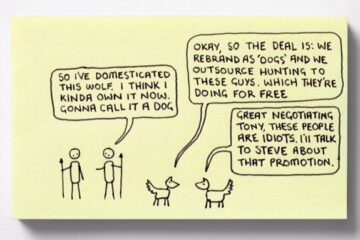Listen, I’m no Pollyanna.
We’re entering the deepest recession any of us have ever seen – maybe even a depression.
And, for some businesses, there’s no salvation. You can “pivot” until the cows come home but, even if you hit on something that works, your old business is dead.
So why am I suggesting that, for most businesses, 2020 can still be their best year ever?
Two reasons…
First, most business owners are so consumed by the day-to-day running of their business that they don’t stop and think about their strategy.
Second, because, if you’re coasting along, doing well, how motivated are you to maximise your profits?
OK, I’m sure that’s not you. It’s 95% of business owners… but not you.
Sure.
So this slowdown is an opportunity to get off the hamster wheel and really think about what you’re doing.
The hardest kind of work
Henry Ford once said, “Thinking is the hardest kind of work — which is probably the reason so few engage in it.”
That’s the bad news: Thinking strategically about your business is hard work.
The good news?
If you do it, and do it well, it can really pay off.
All you need is the right lever. Or, indeed, any lever.
And I’m about to give you five levers…
The most powerful force in marketing
As you may know, Albert Einstein once declared compound interest to be “the most powerful force in the universe.”
(You might also know he probably never said this… but it doesn’t matter. I’m going to pretend he did.)
Well, compound interest works in your business, too.
Take a typical PPC ecommerce funnel.
(Other business models, such as B2B lead generation and SaaS work similarly)
#1: Someone does a Google search and your ad shows.
#2: They click on your ad.
#3: They arrive on your site and convert.
#4: They spend $X.
#5: You use a follow-up sequence and get them to spend $Y more.
That’s 5 steps.
The first 4 of them multiply together – like compound interest. Let’s call that the “immediate profits.”
The 5th step – which most companies don’t even do – we’ll call “additional profits.”
Let’s see how they work together…
Here are some made up numbers
So let’s plug in some semi-random numbers:
| Stage | Metrics | |
| 1 | Impressions | 100,000 |
| 2 | Click rate | 5% |
| 3 | Conversion rate | 2% |
| 4 | Gross profit per sale | $120.00 |
| 5 | Additional profits | $50.00 |
Now, using these numbers, let’s see how visitors flow through the funnel and turn into money:
| Stage | ||
| 1 | Impressions | 100,000 |
| 2 | Clicks | 5,000 |
| 3 | Number of sales | 100 |
| 4 | Immediate profits | $12,000 |
| 5 | Additional profits | $5,000 |
| Total Profit | $17,000 |
OK, now let’s assume you’re paying $2/click.
You’ve spent $10,000 to get 5,000 clicks. Those 5,000 visitors have returned $12,000 straight away.
And, down the line, you’ll make an extra $5,000 from repeat sales.
That’s not bad. You’ve spent $10,000 to make $17,000 – a 70% profit.
How to double or triple your sales by being bad at marketing
Now, let’s imagine you suck at marketing – and you don’t want to hire anyone to help you fix that.
But let’s also imagine that, although you suck, you at least have the ability to act like a dog with a bone and keep testing random stuff.
So let’s imagine that, for 3 months, you doggedly try to improve each of the 5 steps.
And by working hard – without working smart – you improve each one by 20%. That’s usually very easy to do.
Your numbers become…
| Stage | Metrics | |
| 1 | Impressions | 120,000 |
| 2 | Click rate | 6% |
| 3 | Conversion rate | 2.4% |
| 4 | Gross profit per sale | $144.00 |
| 5 | Additional profits | $60.00 |
And the visitors/money flowing through the website:
| Stage | ||
| 1 | Impressions | 120,000 |
| 2 | Clicks | 7,200 |
| 3 | Number of sales | 172.8 |
| 4 | Gross profits | $24.883.20 |
| 5 | Additional profits | $10,368 |
| Total profits | $35,251.20 |
At $2/click, you’ve spent $14,400. That’s up 44%.
But your total profits have more than doubled from $17,000 to $35,251.20.
And your profit – after subtracting the cost of clicks – has gone from $7,000 to $20,851.20.
It’s almost tripled.
Not bad. After all, if you could triple your sales in the fourth quarter of 2020, that would make up for lost sales from Q2 and Q3.
But we’re not finished…
The second thing that makes this work
So, that’s nice: you’ve tripled your profit.
Except… you haven’t.
You see, there are two types of costs in business: fixed costs and variable costs.
Now, I find some business owners have problems with this, so here’s the simplest explanation…
A variable cost is a cost that increases if you make one additional sale.
So let’s say you make 1,000 sales a year.
Now imagine you increase that by 1, to 1,001.
Which of your costs has increased?
Those are your variable costs.
Everything else is a fixed cost.
So the cost of wages is fixed. The rent for your office is fixed…
Even your advertising costs are fixed. That might sound strange, but if you get one extra sale without increasing your ad spend,
Almost all your costs are fixed.
And, in a way, that’s a good thing. It means that, as your sales increase, your profits will increase far faster.
So, if you have a business that’s doing $2m in gross sales (revenue minus variable costs) and your fixed costs are $1.5m, your profit is $500,000.
But, if you increase your gross sales by 50%, they increase to $3m, but your fixed costs are still $1.5m. Your profit just tripled to $1,500,000.
50% increase in sales. 200% increase in profits.
(Yes, this is simplistic – depending on your business, increasing sales may force you to hire more people, rent a bigger office etc.)
So, to go back to our numbers…
If you triple your gross profits, you might be increasing your actual profits by 500% or 600%.
And this is why I’m saying 2020 could still be your best year ever.
All the best,
Steve Gibson
PS If you think 20% improvements in 3 months is difficult, let me tell you a story…
Last year, a SaaS company hired me to analyse their PPC account. After I’d gone through it, I told them I thought they could increase their PPC profits by 600% in 6 months.
(Using a version of what I just showed you.)
To me, these were conservative projections, but they were sceptical. After all, 600% seems huge.
But they decided to dip their toe in the water and hired me to work on just one of the levers I described above.
What happened?
Within one month, I’d improved performance by 70%.
That was just one of the levers. And this was a big company with a big marketing team.
But, if you use this strategy – and know how to implement it – you can get gains like that.



